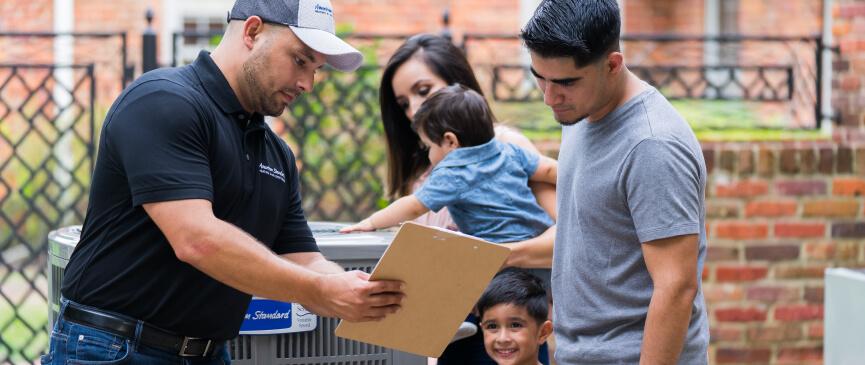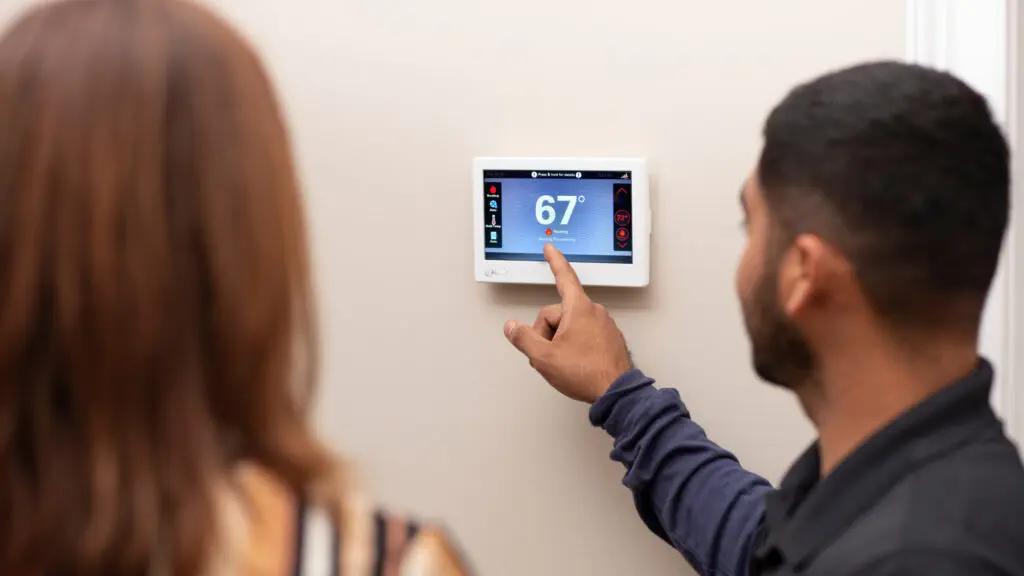Smart Thermostats: Control Comfort and Costs the Smart Way
Key takeaways: Choosing the best thermostat means choosing the best smart thermostat. Compare smart thermostats with traditional thermostats and you’ll see why.

By Anne Fonda
Discover what factors to think about when picking the best thermostat for your home, based on your HVAC system and preferences, and why smart thermostats reign supreme.
Staying comfortable in your home, saving energy, and saving money is easy when you have the right smart thermostat. With this article, we hope to help you answer the question “How do I know which thermostat I need?”
You’ll learn about:
Let’s get started.
Your home’s thermostat works to control the temperature. It senses the indoor temperature and signals your air conditioner, heat pump, or furnace to kick in to heat or cool your home to the desired temperature. For such a small component, it plays an outsized role in making your home comfortable.
Whether you’re getting a new thermostat as part of an HVAC system replacement or you just want an upgrade, you have a lot of options. There are several important factors to consider when choosing a thermostat for your home. The technology has evolved over the years and you have new types of thermostats to choose from. Some top considerations include:
- Compatibility. This is the first thing to consider. For example, not all thermostats are heat pump thermostats. You will need to know the type of system you have (forced air, boiler, etc.) as well as how many heating and cooling stages your system has. Your HVAC dealer can help ensure compatibility.
- Programmability. Decide if you want a standard programmable thermostat where you set a 7-day or 5-1-1 schedule.
- Smart features. Decide if you want to upgrade to a smart thermostat with additional comfort and energy-efficient features with remote access.
- Interface. Decide if you want an intuitive touchscreen interface or a basic digital display.
- Customization. Decide if you want customization options for ease of use and preferences.
No. A replacement thermostat must be compatible with your HVAC system and the wiring where the existing thermostat is. Single-stage, two-stage, and variable-speed systems may not be compatible with all thermostats. An HVAC professional can tell you what thermostats are compatible with your system and wiring.
Smart thermostats connect to your home’s WiFi network, which is why they’re also known as WiFi thermostats. They are the premium level of programmable thermostats, taking things much further than simply programming your temperature preferences.
Using cloud technology and an app, you can control and adjust your home temperature and humidity remotely - from your smartphone, tablet, laptop, or computer. You get enhanced comfort, convenience, and energy savings. You can monitor your energy usage and make adjustments at any time of the day or night, from anywhere in the world with internet access.
Depending on the smart thermostat model, features can include:
- Full programmability with up to 4 daily heating and cooling periods
- Remote access via the American Standard Home App
- Voice assistant compatibility
- W-Fi or ethernet connection
- Compatibility with American Standard AccuLink™ and variable-speed systems
- Zoning capability
- 4.3-7” touchscreen
- Color or LCD touchscreen
- Weather alerts, forecasts, and radar
- Built-in humidity sensors
- Increased Dehumidification Solution (IDS)
- Relative humidity display
- Whole-home humidifier control in heating
- Maintenance alerts
- Upgradable software
- Boiler support
Are you wondering “Do I need a smart thermostat”? Maybe. Smart thermostats are popular choices these days as more and more homeowners are looking for sustainable solutions to help them save energy and reduce their carbon footprint.
Some can even learn your habits and temperature preferences and independently establish a heating and cooling schedule for when you are home and active, when you are sleeping, and when you are away. Utilizing room sensors that measure temperature and humidity levels, they provide superior home comfort and control.
Choosing the best smart thermostat has its own set of considerations. Some newer variable-speed HVAC systems and zoning systems require a smart thermostat as part of the system controls. But you can also replace an older thermostat with a smart thermostat. Just ensure that your system is compatible before making a purchase. An HVAC professional can help you sort through your options to optimize your heating and cooling system.
There are a lot of smart thermostats on the market right now. Not all of them are compatible with all systems, and improper installation can cause issues. If you’re considering a Nest® thermostat or ecobee® thermostat, consult your American Standard dealer to ensure the unit is compatible with your system and find out why it might not be the best choice.
Ideally, if you’re intrigued by the power of remote monitoring and remote diagnostics, you’ll opt for an American Standard smart thermostat. You don’t need to have an American Standard HVAC system to reap the benefits of connecting your dealer with your HVAC system.
Both the Gold 824 and the Silver 724 smart thermostats are compatible with most conventional 24V central HVAC, heat pump, and dual fuel systems.
While the other guys have a warranty of 1-3 years, American Standard smart thermostats come with a 10-year registered warranty (5 for the 724) if installed by an American Standard professional and you or your dealer registers it within 60 days of installation. Even our base limited warranty is better - generally 5 years (1 year for the 724).
Simply download the American Standard Home App to control your HVAC system from anywhere, at any time to start reaping the benefits.
“Both the Silver 724 and Gold 824 are compatible with Dealer Diagnostics and offer runtime history and Smart Diagnostics Alerts (SDAs). Since they are 24V thermostats, they can be installed on other branded systems as well.”
- Michael Morey, Smart Thermostat Product Manager
Only an American Standard smart thermostat lets you opt in for remote diagnostics via the app. This gives your local American Standard dealer access to your smart thermostat data to see what is going on with your HVAC system at any given time. You only need to do this once. It allows your dealer to spot a problem even if you’re not home to notice.
You can’t do this with any other brand of smart thermostat.
The dealer can see:
- Temperature and humidity data
- How often and for how long your HVAC system has been running
- Your basic HVAC system settings including schedule and configuration
Your dealer will also receive system notifications - from routine maintenance reminders to alerts of system malfunctions. If you opt-in to remote diagnostics, your dealer can troubleshoot the issue and can sometimes solve it remotely.
If your dealer feels they can solve an issue remotely, they can request remote access to your thermostat. Remote access is separate from American Standard Diagnostics, and you will have to grant or deny access each time. Access ends when the dealer has completed work. At no time can the dealer see anything about other connected systems in your home.
Other smart thermostats can’t offer this peace of mind.
A word about privacy
At no time can your HVAC dealer see any data from any other smart device in your home. They can only see into your HVAC system. Your data remains encrypted for your security.
Programmable thermostats are a big step up from older manual thermostats, but they’re no competition for smart thermostats. It’s sort of like comparing a non-smart flip phone that saves your contacts and gives you basic calling and text features to the latest iPhone with all the bells and whistles, including AI features.
All smart thermostats are programmable, but not all programmable thermostats are smart. A standard programmable thermostat allows you to set a heating and cooling schedule for your home. Common schedules are one schedule for weekdays and a separate schedule for weekends, with different settings for different times of day.
For example, you can set a wake-up temperature, a daytime temperature, an evening temperature, and a sleep temperature.
Depending on the model, programmable thermostat features can include:
- Full programmability
- Interactive touchscreen
- Compatibility with up to 4 heating stages and 2 cooling stages
- Compatibility with dual-fuel heat pump systems
- Auto changeover between heating and cooling
- Up to 3 fan options
- Filter change reminders
- Humidifier pad change reminders
- Relative humidity display
- Keypad lock
- Optional indoor and outdoor temperature sensors
Programmable thermostats are compatible with most forced-air HVAC systems.
Using our phone analogy, comparing a traditional thermostat to a smart thermostat is like comparing a rotary telephone to the latest iPhone with AI technology. The technology gap is wide.
However, if you’re used to adjusting the temperature yourself and want to keep doing it that way, a basic, non-programmable thermostat might be for you. They are simple and easy to use. In addition, rather than squint at the numbers and move a toggle switch or dial, most non-programmable options today are digital thermostats with a large display and control buttons to raise or lower the temperature.
However, they lack the programming features that can help you save money and save energy. They also do not give you maintenance reminders such as when to change the air filter or humidity pad.
With a programmable or smart thermostat, you can program temperature schedules to save energy. There is no reason to heat or cool your home the same when you’re gone as when you’re at work.
Set a lower temperature in the winter for when the house is empty, and set a higher temperature in the summer when no one is home. The closer the indoor temperature is to the outdoor temperature, the better it is for reducing your energy costs.
In addition, some smart thermostats have learning capabilities and can independently adjust the temperature and humidity levels for superior comfort. Monitoring your energy consumption can lead to increased savings for you, and can be beneficial to the planet. It’s a win-win!
And if you still have a manual, non-programmable thermostat, you can set reminders for yourself to turn the temperature down/up before you leave the house. You won’t have quite the same savings, but every little bit helps.
While you can install some programmable and smart thermostats you might buy online or at a big box store, American Standard smart thermostats require professional installation. This ensures you can get the most out of your new thermostat and that it is installed correctly.
Professional installation by your local HVAC contractor also means you get professional support and troubleshooting advice. And of course, if you get one of our smart thermostats, you can enable remote diagnostics as mentioned earlier.
The best smart thermostat for your home is one that is compatible with your HVAC system, and one where you will take full advantage of the features it has to offer.
If you’re investing in an HVAC system replacement, get a smart thermostat to achieve optimal efficiency and control. If you have an older system but want to make it easier to save energy, upgrade to a compatible smart thermostat.
If you are not very tech-savvy, don’t worry. Once you program your smart thermostat, you can set it and forget it. But remember that control of your system is in the palm of your hand.
We’ve created some instructional videos to guide you through setup, step by step. Contact your local American Standard dealer for assistance, or to schedule a thermostat replacement.
Silver 724 setup instructional video
Gold 824, Acculink Platinum 850, Acculink Platinum 1050 setup instructional video
Link UX 360 setup instructional video
Anne Fonda, Content Writer
A Content Writer with Trane Technologies, Anne Fonda researches topics and writes for Trane® and associated residential HVAC brands. She works in collaboration with Trane Technologies subject matter experts, offering easy-to-understand, informative content on complex topics. Her goal is to help consumers make informed decisions on the products and services they need.
She has written for HVAC and other service provider websites for over 16 years. Before transitioning to web content writing, Anne had a 14-year stint as an award-winning journalist. She graduated cum laude from the University of Missouri-Columbia School of Journalism.
When she’s not working, Anne enjoys playing word games, reading, gardening, spending time with family, and visiting gardens and museums.
Expert review by Michael Morey, Smart Thermostat Product Manager



